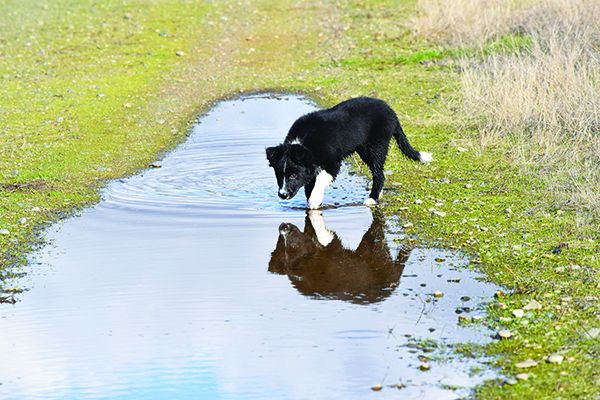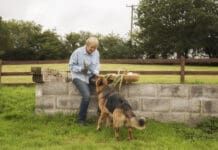
Leptospirosis is a disease caused by bacteria shed in the urine of infected wildlife. Deer, skunks, and raccoons are the biggest reservoirs, although rodents like mice and rats carry it too. Leptospirosis typically causes severe kidney and liver damage, which can sometimes be fatal. It is a zoonotic disease, which means it infects humans as well.
For all of these reasons, it’s important for dog owners to be aware of this disease, understand how it is spread, know what signs to watch for, and most importantly, learn the best ways to prevent it.
BACTERIAL VILLIAN
The leptospire is a particular type of bacteria called a spirochete. It’s unique from other bacteria in that it cannot be easily cultured in a laboratory, which makes it a challenge for your veterinarian to definitively diagnose your sick dog.
The leptospire multiplies in the kidneys of reservoir hosts, such as deer, skunks, and raccoons. Reservoir hosts are those that have adapted to this organism and therefore do not fall ill with disease; they merely carry the organism and shed it in their urine. The leptospire doesn’t multiply once it’s shed into the environment, but it can survive for weeks or even months in warm, wet conditions. It loves stagnant water, puddles, and muddy soil – this is where you and your dog are most likely to encounter it.
Species who become ill with leptospirosis are called incidental hosts. These include both dogs and humans. The leptospire enters the incidental host through mucous membranes (either when swimming or drinking from mud puddles) or through breaks in the skin (again, either through swimming or just tracking through mud with cuts or open sores).
Once inside a susceptible host, leptospires multiply rapidly in the bloodstream, where they immediately start damaging the lining of blood vessels. This blood vessel injury then leads to organ damage. The kidneys and liver are most commonly affected, but leptospirosis can cause injury to the lungs, eyes, and central nervous system.
RISK FACTORS
The risk to your dog depends on your geographical location, home environment, lifestyle, and time of year.
Leptospirosis is a global disease, most prevalent in areas with high rainfall and warmer climates. In the United States, Hawaii is the biggest hot bed for leptospirosis, but cases have been documented all over the country. Numbers are high on the West Coast, in the upper Midwest, as well as in the Northeast, Southeast, and mid-Atlantic coastal regions. Case numbers in the United States peak in late fall.
Home environments with a high neighborhood wildlife population pose a greater risk, especially if your yard is not fenced to keep larger animals like deer out.
If your lifestyle includes hiking, camping, or walking in parks or wooded areas with your dog, your risk of exposure to leptospirosis is higher. If you live in an urban area with a more sedentary or indoor lifestyle, your risk is much lower, although mice and rats can be carriers.
While a rise in leptospirosis cases in urban areas has been documented, I’m hard pressed to believe that the amount of urine a mouse leaves behind is as significant as that of a deer in terms of exposure. No risk, however, is better than low risk, so rodent control in urban environments is recommended.
SIGNS AND DIAGNOSIS

If your dog becomes infected with leptospirosis, the signs can be variable but almost always include lethargy and loss of appetite. Fever, vomiting, diarrhea, excessive thirst, and urination are common. Icterus (yellow mucous membranes) frequently occurs when there is liver involvement.
Less common but possible signs include muscle pain, abdominal pain, and inflammatory eye conditions. If the lungs become damaged, difficulty breathing and coughing up blood can occur. Lung involvement, which carries a much graver prognosis, is fortunately not common.
Diagnosing leptospirosis in dogs is challenging. Your veterinarian will use a combination of history, physical exam findings, blood tests, and urinalysis to arrive at an initial index of suspicion for this disease. If it’s high enough, the next step includes submission of blood for a test called a microscopic agglutination test (MAT). This test looks for antibodies against leptospirosis. Sounds simple, right? It’s not!
Several complicating factors make a single MAT insufficient for definitive diagnosis of leptospirosis. First, antibodies are not always identifiable early in the course of a disease. It takes time for the immune system to form antibodies.
The best way to know for sure is to look at paired samples, one taken right away (the acute titer) and one taken two weeks later (the convalescent titer). If this shows a fourfold or greater increase in titer, it is considered diagnostic for leptospirosis. But we can’t wait two weeks to start treatment for leptospirosis! It’s imperative that your dog be started on appropriate antibiotic therapy as early as possible.
To make matters worse, antibiotic therapy may dampen the rise in the antibody titer we use for making a definitive diagnosis. So while it may well be leptospirosis, it might not look like it, based on a lack of rising titer in the paired samples. This is frustrating, but I have learned that as long as the initial index of suspicion is high enough, the patient receives early appropriate therapy, and makes a full recovery, it’s all good. We just won’t be able to say it was definitely leptospirosis in this situation; we can only say it probably was.
Here are two more factors that can confound diagnosis: Vaccinated dogs can still succumb to active infection! And dogs who have been vaccinated for leptospirosis will display vaccine-induced antibodies on a titer test!
This means when a vaccinated dog comes in with signs suggestive of leptospirosis, and has a positive titer on the MAT, there’s no way to differentiate active infection antibodies from vaccine-induced antibodies. Does he have leptospirosis or not? Only time will tell. In the meantime, you can bet I’m treating him for it.
A polymerase chain reaction (PCR) test, which looks for the actual DNA of the leptospire organism and is not affected by vaccination status, is currently available. These tests can identify disease earlier, but their accuracy is still under investigation. This means that if the PCR comes back negative, it would still be prudent to initiate treatment if the veterinarian’s index of suspicion is high.
TREATMENT
While diagnosis can be tricky, treatment is more straightforward. The leptospire organism is not sensitive to many antibiotics, but fortunately it is highly sensitive to a few. This means if your dog gets a swift, accurate diagnosis, and appropriate treatment is started early in the course of the disease, you can usually expect a good outcome; as many as 80% of dogs handled in this manner will make a full recovery.
Appropriate antibiotic therapy is paramount to a successful outcome. Penicillin, or its derivative ampicillin, is usually instituted early, as these drugs eliminate the bacteria from the bloodstream. Doxycycline is typically given for at least two weeks, as this antibiotic helps clear the organism from the kidneys. Anti-emetics (anti-vomiting) and pain medications are administered as needed.
Treatment almost always involves admission to the hospital for several days or longer, depending on the severity of disease. Kidney and liver involvement requires aggressive intravenous fluid therapy and close professional monitoring. Patients with severe kidney failure who fail to respond to intravenous fluid therapy should be referred to a specialty center for dialysis.
Once discharged from the hospital, your dog will require close monitoring for several months, although a good prognosis can be given at this point.
Your veterinarian will advise you on how to safely handle your dog’s urine at home, which includes wearing gloves when cleaning it up. Routine household disinfectants with bleach are effective against this bacteria, so using a yard sprayer and a bleach solution to spray each place where your dog urinates in your yard would be prudent.
If you have other dogs, be sure to ask your vet about proactively treating the others with doxycycline, just in case. I know my dogs drink from, and track through, all the same puddles when we are out and about. If one becomes infected, there’s a good chance the other has been exposed.
PREVENTION
Effective rodent control, indoors and out, is always a good idea. A fenced yard will help keep the larger wildlife reservoirs like deer from urinating where your dog goes out. Other than keeping your dog in a bubble, there is always an environmental risk of exposing your dog to leptospires!
This is where vaccination comes in. The canine leptospirosis vaccines that are currently available all protect against four serovars of the bacteria. While the four serovars in the vaccine are not the only serovars your dog may encounter in the United States – more than 200 different leptospirosis serovars have been identified – they are the most common. Furthermore, the vaccine provides some cross-protection from the other serovars. Even better, there is some evidence that vaccinated dogs who become infected with leptospirosis may experience less severe disease.
I recommend waiting until 12 weeks of age to start the leptospirosis vaccine. The initial series requires two doses, given three weeks apart. Thereafter, an annual booster is given. In locations where veterinarians see a lot of cases, your vet may recommend boostering more frequently than that, perhaps as often as every six to nine months, based on their clinical experience.
ADVERSE EFFECTS?
You may have heard about or had your own negative experiences with the leptospirosis vaccine in the past. As a practicing veterinarian, I can attest to the fact that years ago, this vaccine seemed to cause significantly more, and significantly worse, adverse reactions in dogs than other vaccines. The smaller breeds, especially Pugs and Dachshunds, were definitely over-represented when it came to reactions associated with the leptospirosis vaccine. Breeders of small breed dogs would frequently warn their puppy buyers of the danger of this vaccine and strongly advise against it.
Fortunately, with the markedly improved vaccines in use today, this is no longer the case. Recent studies have shown this vaccine to be no more reactive than any of the other routine canine vaccines.
Vaccination, however, is never without risk, which is why I recommend a disease risk-assessment for each individual dog before deciding which vaccines are appropriate for that dog. Any time you or your dog receives a vaccine, you are accepting a certain amount of risk. Reactions range from mild (just not feeling well for 24 hours) to moderate (hives and/or vomiting and diarrhea) to severe (life-threatening anaphylactic shock). Vaccination can also have delayed reactions that show up weeks later in the form of auto-immune disease.
That’s why, if your dog has minimal or no risk of getting a disease, it might not make sense to expose your dog to the inherent risks associated with vaccination. The current American Animal Hospital Association Vaccination Guidelines support this idea by listing leptospirosis as a “non-core” vaccine, meaning it may not be appropriate for all dogs. Examples of core vaccines, which are recommended for all dogs, include distemper, parvovirus, and rabies.
The bottom line is, don’t be afraid of getting a leptospirosis vaccine for your dog, but do a thoughtful risk assessment, considering your environment and lifestyle, before deciding. If your yard can be accessed by skunks, raccoons, and deer, or you have a heavy wildlife population near your home, your dog’s risk is higher. Dogs who are taken camping or hiking in areas where wildlife is present are also at a higher risk.
Ultimately, whether or not to vaccinate your dog for leptospirosis is up to you. As always, the best advice for you and your dog comes from your veterinarian.






Are squirrels a source?
yes
Thank you for this good and timely article. I’ve been contemplating getting my two dogs vaccinated for lepto. I believe the risk to be low for my geographic area, local environment and lifestyle. On the other hand, my daughter, who is a vet is encouraging me to vaccinate. She lives in a different state, sees a few cases per year and believes it’s better to be safe than sorry. Your article helped me to clarify the issue and make a more informed decision to not take the risk of vaccination at this time.
The article states that “vaccinated dogs can still succumb to active infection”. Meanwhile, the article states that there is an increase in Leptospirosis cases that happens to coincide with an increase in Leptospirosis vaccinations. Sounds like a lot of things we hear these days. Auto-immune diseases are horrible. Careful with the overzealous shot givers.
What is the point of vaccination if it causes complications and doesn’t protect my dog? This is the same reason I stopped the Lyme shots because they still ended up getting Lyme Disease. Just another way to make money off our pets.
Once long ago I had a dog succumb to AIHA and the specialty vet thought it was due to the lepto vaccine which he had received just a few weeks earlier for the first time in his life. Since then I have never had my dogs vaccinated for this. However, your article really opened my eyes about this disease and I’m optimistic after reading it about the new improved vaccines. One question: I’m not clear on why the frequency of the vaccine is necessary. Would annual titers be better and then vaccination based upon what the titers show? Thank you.
My dogs are vaccinated for this, but it has always worried me. My dogs and I hike off leash. It’s impossible to keep dogs out of puddles; they really heat up off leash. It does seem to have significant symptoms. An owner seems unlikely to miss them if a dog gets afflicted. Thanks for the informative article.
I am glad that at the end you did talk about the side effects and that there are differing risks and risk environments. Hopefully everyone reading the article will read to the end.
Lepto is being seen more frequently because testing has improved so it is being diagnosed more accurately; more people are travelling into remote areas with their dogs…and we encroach on wildlife habitat.
Unfortunately, there are many risks associated with ‘routine’ vaccines. In fact many should not be considered routine especially with the availability of titer testing.
Even Schultz discussed the fact that many vaccinations lasted for years – some for even the life of the animal …and well beyond the recommendation included on vaccine labels.
One important thing that I feel should have been stressed as precautions – especially if you live in an an area with higher risk or partake in activities that lead to higher risk of exposure is that it is important to boost your dogs immune system and feed a species appropriate balanced diet (speak to a holistic vet that has studied dog nutrition to determine what that should be).
If it is decided to give the vaccination then detox should also been discussed.
Other symptoms that I do not think were mentioned….are due to clotting issues that can be experienced such as bleeding gums and blood in the feces.
I think it should have also been mentioned… that if your dog is diagnosed with lepto; or if it is suspected and you or your family should start exhibiting Flu like symptoms, that as a precaution they should seek medical advice advising their doctor of the possibility of their dog having lepto.
I read continually about the devastating side effects of vaccinating and it is so scary that so many people routinely do so without being educated on the risks.
“Does he have leptospirosis or not? Only time will tell. In the meantime, you can bet I’m treating him for it.”
Right answer!
If you suspect that your dog has been exposed, get them on the proper (doxycycline) antibiotics as quickly as possible. Do not wait for a diagnosis, your dog could die by then.
If you have a dog that licks other animal urine, stop them from doing that. Yes, some dogs do that.
Can you talk about why it’s necessary to boost annually? We know that the core vaccines are good for many years (7+) and we can titer for them. How is the leptospirosis vaccine different?
Sorry, just more fear mongering. Seems to be the way we live now. EVERYTHING is going to kill us and our dogs. NOT.
In my vet’s office, there are ads for the prevention of every type of human disease you can think of that we humans have a vaccine for, now formulated for our pets- everything from canine flu to pneumonia to Lyme’s disease. This has become a huge moneymaker for Big Pharma, who are not adverse to gouging us for unnecessary drugs but now our animal friends as well. The vets also profit from shooting these vaccines into out pets. Is it any wonder why our dogs and cats are more likely to succumb to cancer than any other disease, while the people who we entrust to keep our animals safe and healthy are the very ones to kill them for the money? If this vaccine only works on four of the two hundred strains, may kill your dog in the course of trying to protect him, and may be entirely unnecessary unless you have a parade of infected animals traipsing through the yard, why would you even consider exposing you baby to this poison?
Our late galga presented with what was likely lepto several years ago. This was in Colorado, not one of the higher risk places noted in the article. She presented with lethargy and lack of appetite and seemed painful. It took over $5,000, including emergency vet hospitalization, to save her. She did survive, fortunately, to live another 3 years. I’d recommend the lepto vaccine….and to insist if a dog presents with possible lepto to get them on antibiotics immediately. The first vet who examined her misdiagnosed her and she lost a precious one or two days of treatment.
My dog had a horrible reaction to lepto vaccine.. hi temp, lethargic, hematuria, no appetite or thirst…after he recovered he saw an internal medicine vet and she strongly recommended no other vaccines other than the 3 year rabies.. I do TITERS every 3 years, they are always on a leash, I monitor them on walks as to no drink or eat we avoid muddy areas.. I am never obsessed with the phone when we walk or hike …it’s their time with me
My German Shepherd had a seizure one hour after the lepto vaccine – never again.
One of my Pharaoh Hounds became infected with Leptospirosis. He was vaccinated but the strain that infected him was not in the vaccine. He was lethargic, in pain, suffered incontinence and could barely stand up. I believe, the vax lessened his symptoms. I, too, became infected si I know first hand what my dog was feeling. I suffered for 8 months before I found a doctor who would test me for Lepto. The pain and suffering I experienced was unbelievable, every joint and past skeletal injury was on fire with pain. The lethargy was crippling. It felt as if my whole skeleton was made of glass. If you love your dogs, get them vaccinated. I speak from personal experience.
My GSD had a lepto vaccine and an hour later had a seizure
I’ve read all the comments and am now more confused than ever. I know that there’s an uptick in leptospirosis in Los Angeles County, but I worry about over-vaccinating.
When my last Doberman was being treated for lymphoma, I asked her oncologist what things I could do to prevent this from ever happening again to any dog of mine. Her advice was to limit vaccines to those that are essential. On the other hand, we live in an area with a whole lot of dogs, a fair number of coyotes, and some other less-than-desirable visitors. Then one goes to the dog show and watches as the judge opens and puts their hands in the mouths of each dog without so much as a swipe of Purell between each exam. So I really want to vaccinate my dog. I just wish we knew for certain that the vaccine is safe and effective.
I agree, I am even more uncertain about what to do after reading the article. I have been considering getting my dog the vaccine considering that he is basically a mud puppy and he loves every bit of water he can get into. Some friends have recently been talking about the “pond“ shot and had their dogs get it. There is a pond next to our dog park that some let their dogs go in on a regular basis, I am leery of it. My dog has been in there a couple times but I have concerns since there is wildlife in the area. I haven’t personally talked to the vet about it but plan to do so.
I would highly recommend getting any dog vaccinated for Leptospirosis. After waiting over four years until we retired to get a puppy, we finally got a flat-coated retriever puppy at the beginning of December. He was wonderful, but seemed a bit tired a few days before Christmas. He was 12 weeks old. On Christmas Eve morning, he vomited, but then ate his food the rest of the day, and seemed okay. On Christmas Day, he would not eat and was very lethargic. We tried giving him pedialyte and ground up chicken which he ate, and it seemed to perk him up. But a half hour later he threw up, so we took him to an emergency hospital. After two days he’d had renal and liver failure and we had to euthanize him. It was devastating. The PCR test came back a week later and was positive for Leptospirosis.
I had asked my vet about the vaccine, and she advised against it due to the side effects. It would not have helped our puppy anyway, because he was so young. But the disease is terrible, and comes on fast. Any future dog we may have will be vaccinated.
Our 3 year old dachshund/lab mix had his 2nd annual lepto only vaccine yesterday morning and just like last year had a reaction begin about 90 minutes after. Extreme lethargy and tendernesses all over. We called the vet and she said to give him a tramadol dose which did seem to help a bit. He would barely walk, stood or sat in place for several minutes at a time looking scared but wouldn’t let us touch him. He eventually went into his crate and wouldn’t come out until dinner time. He’s normally extremely high energy and is constantly running to the windows looking for squirrels, or sitting in my lap looking out the window for squirrels, or racing in the yard chasing squirrels. None of that yesterday, but today he seems fine except for a bit of soreness at the injection site. (Admittedly he’s very much a baby about pain or anticipating pain.) We are in a high risk rural area with rodents, deer etc, and to top it off he is prone to eating whatever he finds interesting – acorns, scat, bird droppings so he’s a candidate for contracting lepto. But even so I’m afraid to give him this vaccine again.